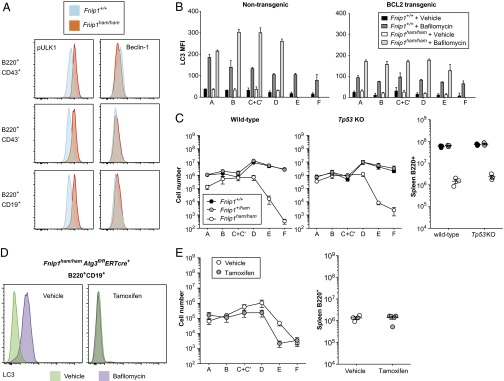Fig. 6.
Autophagosome formation is increased in Fnip1 mutants but is not responsible for B-cell deficiency. (A) Bone marrow B cells were permeabilized and stained for S555 phospho-ULK1 (pULK1) and Beclin-1. (B) Bone marrow cells from wild-type or Fnip1 mutant mice (with or without the EμBCL2 transgene) were stained for LC3 in the presence or absence of bafilomycin (which inhibits degradation of LC3-II expressing autophagosomes). Hardy fractions were gated as in Fig. 3 (A, B220+CD43+BP-1−CD24−; B, B220+CD43+BP-1−CD24+; C+C′, B220+CD43+BP-1+CD24+; D, B220+CD43−IgM−IgD−; E, B220+CD43−IgM−IgD+; F, B220+CD43−IgM+IgD+). (C) Absolute numbers of bone marrow B-cell subsets and splenic B220+ cells in mice with or without a homozygous null allele of Tp53. (D) LC3-staining intensity in B220+CD19+ B cells from Fnip1ham/hamAtg3fl/flERT2cre+ mice treated with tamoxifen or vehicle control. Cells were incubated in the presence or absence of bafilomycin. (E) Absolute numbers of bone marrow B-cell subsets and splenic B220+ cells in Fnip1ham/hamAtg3fl/flERT2cre+ mice treated with vehicle (Atg3-sufficient) or tamoxifen (Atg3-deficient).

